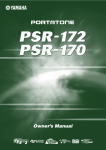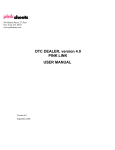Download Yamaha NP-30
Transcript
NP-30 YNP-25 Digital Keyboard Owner’s Manual SPECIAL MESSAGE SECTION This product utilizes batteries or an external power supply (adapter). DO NOT connect this product to any power supply or adapter other than one described in the manual, on the name plate, or specifically recommended by Yamaha. WARNING: Do not place this product in a position where anyone could walk on, trip over, or roll anything over power or connecting cords of any kind. The use of an extension cord is not recommended! If you must use an extension cord, the minimum wire size for a 25’ cord (or less) is 18 AWG. NOTE: The smaller the AWG number, the larger the current handling capacity. For longer extension cords, consult a local electrician. This product should be used only with the components supplied or; a cart, rack, or stand that is recommended by Yamaha. If a cart, etc., is used, please observe all safety markings and instructions that accompany the accessory product. SPECIFICATIONS SUBJECT TO CHANGE: The information contained in this manual is believed to be correct at the time of printing. However, Yamaha reserves the right to change or modify any of the specifications without notice or obligation to update existing units. This product, either alone or in combination with an amplifier and headphones or speaker/s, may be capable of producing sound levels that could cause permanent hearing loss. DO NOT operate for long periods of time at a high volume level or at a level that is uncomfortable. If you experience any hearing loss or ringing in the ears, you should consult an audiologist. IMPORTANT: The louder the sound, the shorter the time period before damage occurs. Some Yamaha products may have benches and / or accessory mounting fixtures that are either supplied with the product or as optional accessories. Some of these items are designed to be dealer assembled or installed. Please make sure that benches are stable and any optional fixtures (where applicable) are well secured BEFORE using. Benches supplied by Yamaha are designed for seating only. No other uses are recommended. NOTICE: Battery Notice: This product MAY contain a small non-rechargeable battery which (if applicable) is soldered in place. The average life span of this type of battery is approximately five years. When replacement becomes necessary, contact a qualified service representative to perform the replacement. This product may also use “household” type batteries. Some of these may be rechargeable. Make sure that the battery being charged is a rechargeable type and that the charger is intended for the battery being charged. When installing batteries, do not mix batteries with new, or with batteries of a different type. Batteries MUST be installed correctly. Mismatches or incorrect installation may result in overheating and battery case rupture. Warning: Do not attempt to disassemble, or incinerate any battery. Keep all batteries away from children. Dispose of used batteries promptly and as regulated by the laws in your area. Note: Check with any retailer of household type batteries in your area for battery disposal information. Disposal Notice: Should this product become damaged beyond repair, or for some reason its useful life is considered to be at an end, please observe all local, state, and federal regulations that relate to the disposal of products that contain lead, batteries, plastics, etc. If your dealer is unable to assist you, please contact Yamaha directly. NAME PLATE LOCATION: The name plate is located on the bottom of the product. The model number, serial number, power requirements, etc., are located on this plate. You should record the model number, serial number, and the date of purchase in the spaces provided below and retain this manual as a permanent record of your purchase. Service charges incurred due to a lack of knowledge relating to how a function or effect works (when the unit is operating as designed) are not covered by the manufacturer’s warranty, and are therefore the owners responsibility. Please study this manual carefully and consult your dealer before requesting service. Model ENVIRONMENTAL ISSUES: Purchase Date Serial No. Yamaha strives to produce products that are both user safe and environmentally friendly. We sincerely believe that our products and the production methods used to produce them, meet these goals. In keeping with both the letter and the spirit of the law, we want you to be aware of the following: 92-BP (bottom) 2 PLEASE KEEP THIS MANUAL NP-30/YNP-25 Owner’s Manual FCC INFORMATION (U.S.A.) 1. IMPORTANT NOTICE: DO NOT MODIFY THIS UNIT! This product, when installed as indicated in the instructions contained in this manual, meets FCC requirements. Modifications not expressly approved by Yamaha may void your authority, granted by the FCC, to use the product. 2. IMPORTANT: When connecting this product to accessories and/ or another product use only high quality shielded cables. Cable/s supplied with this product MUST be used. Follow all installation instructions. Failure to follow instructions could void your FCC authorization to use this product in the USA. 3. NOTE: This product has been tested and found to comply with the requirements listed in FCC Regulations, Part 15 for Class “B” digital devices. Compliance with these requirements provides a reasonable level of assurance that your use of this product in a residential environment will not result in harmful interference with other electronic devices. This equipment generates/uses radio frequencies and, if not installed and used according to the instructions found in the users manual, may cause interference harmful to the operation of other electronic devices. Compliance with FCC regulations does * This applies only to products distributed by YAMAHA CORPORATION OF AMERICA. not guarantee that interference will not occur in all installations. If this product is found to be the source of interference, which can be determined by turning the unit “OFF” and “ON”, please try to eliminate the problem by using one of the following measures: Relocate either this product or the device that is being affected by the interference. Utilize power outlets that are on different branch (circuit breaker or fuse) circuits or install AC line filter/s. In the case of radio or TV interference, relocate/reorient the antenna. If the antenna lead-in is 300 ohm ribbon lead, change the lead-in to co-axial type cable. If these corrective measures do not produce satisfactory results, please contact the local retailer authorized to distribute this type of product. If you can not locate the appropriate retailer, please contact Yamaha Corporation of America, Electronic Service Division, 6600 Orangethorpe Ave, Buena Park, CA90620 The above statements apply ONLY to those products distributed by Yamaha Corporation of America or its subsidiaries. (class B) OBSERVERA! Apparaten kopplas inte ur växelströmskällan (nätet) så länge som den ar ansluten till vägguttaget, även om själva apparaten har stängts av. ADVARSEL: Netspæendingen til dette apparat er IKKE afbrudt, sålæenge netledningen siddr i en stikkontakt, som er t endt — også selvom der or slukket på apparatets afbryder. VAROITUS: Laitteen toisiopiiriin kytketty käyttökytkin ei irroita koko laitetta verkosta. (standby) Entsorgung leerer Batterien (nur innerhalb Deutschlands) Leisten Sie einen Beitrag zum Umweltschutz. Verbrauchte Batterien oder Akkumulatoren dürfen nicht in den Hausmüll. Sie können bei einer Sammelstelle für Altbatterien bzw. Sondermüll abgegeben werden. Informieren Sie sich bei Ihrer Kommune. (battery) IMPORTANT NOTICE FOR THE UNITED KINGDOM Connecting the Plug and Cord IMPORTANT. The wires in this mains lead are coloured in accordance with the following code: BLUE : NEUTRAL BROWN : LIVE As the colours of the wires in the mains lead of this apparatus may not correspond with the coloured makings identifying the terminals in your plug proceed as follows: The wire which is coloured BLUE must be connected to the terminal which is marked with the letter N or coloured BLACK. The wire which is coloured BROWN must be connected to the terminal which is marked with the letter L or coloured RED. Making sure that neither core is connected to the earth terminal of the three pin plug. • This applies only to products distributed by Yamaha-Kemble Music (U.K.) Ltd. (2 wires) NP-30/YNP-25 Owner’s Manual 3 PRECAUTIONS PLEASE READ CAREFULLY BEFORE PROCEEDING * Please keep this manual in a safe place for future reference. WARNING Always follow the basic precautions listed below to avoid the possibility of serious injury or even death from electrical shock, short-circuiting, damages, fire or other hazards. These precautions include, but are not limited to, the following: Power supply/AC power adaptor Water warning • Only use the voltage specified as correct for the instrument. The required voltage is printed on the name plate of the instrument. • Use the specified adaptor (PA-5D, PA-150 or an equivalent recommended by Yamaha) only. Using the wrong adaptor can result in damage to the instrument or overheating. • Check the electric plug periodically and remove any dirt or dust which may have accumulated on it. • Do not place the AC adaptor cord near heat sources such as heaters or radiators, and do not excessively bend or otherwise damage the cord, place heavy objects on it, or place it in a position where anyone could walk on, trip over, or roll anything over it. • Do not expose the instrument to rain, use it near water or in damp or wet conditions, or place containers on it containing liquids which might spill into any openings. If any liquid such as water seeps into the instrument, turn off the power immediately and unplug the power cord from the AC outlet. Then have the instrument inspected by qualified Yamaha service personnel. • Never insert or remove an electric plug with wet hands. Fire warning • Do not put burning items, such as candles, on the unit. A burning item may fall over and cause a fire. If you notice any abnormality Do not open • Do not open the instrument or attempt to disassemble the internal parts or modify them in any way. The instrument contains no user-serviceable parts. If it should appear to be malfunctioning, discontinue use immediately and have it inspected by qualified Yamaha service personnel. • If the AC adaptor cord or plug becomes frayed or damaged, or if there is a sudden loss of sound during use of the instrument, or if any unusual smells or smoke should appear to be caused by it, immediately turn off the power switch, disconnect the adaptor plug from the outlet, and have the instrument inspected by qualified Yamaha service personnel. CAUTION Always follow the basic precautions listed below to avoid the possibility of physical injury to you or others, or damage to the instrument or other property. These precautions include, but are not limited to, the following: • Do not attempt to recharge batteries that are not intended to be charged. Power supply/AC power adaptor • When removing the electric plug from the instrument or an outlet, always hold the plug itself and not the cord. • When the batteries run out, or if the instrument is not to be used for a long time, remove the batteries from the instrument to prevent possible leakage of the battery fluid. • Unplug the AC power adaptor when not using the instrument, or during electrical storms. • Keep batteries away from children. • Do not connect the instrument to an electrical outlet using a multiple-connector. Doing so can result in lower sound quality, or possibly cause overheating in the outlet. • If the batteries do leak, avoid contact with the leaked fluid. If the battery fluid should come in contact with your eyes, mouth, or skin, wash immediately with water and consult a doctor. Battery fluid is corrosive and may possibly cause loss of sight or chemical burns. Battery Location • Always make sure all batteries are inserted in conformity with the +/- polarity markings. Failure to do so might result in overheating, fire, or battery fluid leakage. • Always replace all batteries at the same time. Do not use new batteries together with old ones. Also, do not mix battery types, such as alkaline batteries with manganese batteries, or batteries from different makers, or different types of batteries from the same maker, since this can cause overheating, fire, or battery fluid leakage. • Do not dispose of batteries in fire. • Do not expose the instrument to excessive dust or vibrations, or extreme cold or heat (such as in direct sunlight, near a heater, or in a car during the day) to prevent the possibility of panel disfiguration or damage to the internal components. • Do not use the instrument in the vicinity of a TV, radio, stereo equipment, mobile phone, or other electric devices. Otherwise, the instrument, TV, or radio may generate noise. • Do not place the instrument in an unstable position where it might accidentally fall over. (4)-12 1/2 4 NP-30/YNP-25 Owner’s Manual PRECAUTIONS • Before moving the instrument, remove all connected adaptor and other cables. • When setting up the product, make sure that the AC outlet you are using is easily accessible. If some trouble or malfunction occurs, immediately turn off the power switch and disconnect the plug from the outlet. Even when the power switch is turned off, electricity is still flowing to the product at the minimum level. When you are not using the product for a long time, make sure to unplug the power cord from the wall AC outlet. • Use only the stand specified for the instrument. When attaching the stand or rack, use the provided screws only. Failure to do so could cause damage to the internal components or result in the instrument falling over. • Do not place objects in front of the instrument’s air vent, since this may prevent adequate ventilation of the internal components, and possibly result in the instrument overheating. Maintenance • When cleaning the instrument, use a soft, dry cloth. Do not use paint thinners, solvents, cleaning fluids, or chemical-impregnated wiping cloths. Handling caution • Do not insert a finger or hand in any gaps on the instrument. • Never insert or drop paper, metallic, or other objects into the gaps on the panel or keyboard. If this happens, turn off the power immediately and unplug the power cord from the AC outlet. Then have the instrument inspected by qualified Yamaha service personnel. • Do not place vinyl, plastic or rubber objects on the instrument, since this might discolor the panel or keyboard. • Do not rest your weight on, or place heavy objects on the instrument, and do not use excessive force on the buttons, switches or connectors. Connections • Before connecting the instrument to other electronic components, turn off the power for all components. Before turning the power on or off for all components, set all volume levels to minimum. Also, be sure to set the volumes of all components at their minimum levels and gradually raise the volume controls while playing the instrument to set the desired listening level. • Do not use the instrument/device or headphones for a long period of time at a high or uncomfortable volume level, since this can cause permanent hearing loss. If you experience any hearing loss or ringing in the ears, consult a physician. Yamaha cannot be held responsible for damage caused by improper use or modifications to the instrument. Always turn the power off when the instrument is not in use. When using a power adaptor, even when the power switch is in the “STANDBY” position, electricity is still flowing to the instrument at the minimum level. When you are not using the instrument for a long time, make sure you unplug the AC power adaptor from the wall AC outlet. Make sure to discard used batteries according to local regulations. (4)-12 2/2 NP-30/YNP-25 Owner’s Manual 5 Introduction Thank you for purchasing the Yamaha NP-30/YNP-25! We recommend that you read this manual carefully so that you can fully take advantage of the advanced and convenient functions of the NP-30/YNP-25. We also recommend that you keep this manual in a safe and handy place for future reference. Main Features Graded Touch Keyboard Features well balanced weight gradations of the keys—heavy in the lower end, light in the upper keys. AWM Stereo Sampling The Yamaha NP-30/YNP-25 offers unmatched sonic realism and natural grand-piano type playability as well as Yamaha’s original “AWM Stereo Sampling” tone-generation technology for rich, musical voices. In particular, the Grand Piano 1 and 2 voices feature samples painstakingly recorded from a full concert grand piano, while the Electric Piano 1 and 2 voice features multiple samples for different velocities (Dynamic Sampling); in other words, it uses different samples depending on the strength of your playing. 6 NP-30/YNP-25 Owner’s Manual About this Owner’s Manual This manual consists of three main sections: Introduction, Reference and Appendix. Introduction (page 6): Please read this section first. Reference (page 14): This section explains how to make detailed settings for the instrument’s various functions. Appendix (page 28): This section features a variety of essential, detailed information on the instrument. * The illustrations as shown in this owner’s manual are for instructional purposes only, and may appear somewhat different from those on your instrument. * Copying of the commercially available musical data including but not limited to MIDI data and/or audio data is strictly prohibited except for your personal use. * For the sake of simplicity, both models NP-30 and NP-30S are hereafter referred to in this Owner’s Manual as NP-30. This product incorporates and bundles computer programs and contents in which Yamaha owns copyrights or with respect to which it has license to use others’ copyrights. Such copyrighted materials include, without limitation, all computer software, style files, MIDI files, WAVE data, musical scores and sound recordings. Any unauthorized use of such programs and contents outside of personal use is not permitted under relevant laws. Any violation of copyright has legal consequences. DON’T MAKE, DISTRIBUTE OR USE ILLEGAL COPIES. • The company names and product names in this Owner’s Manual are the trademarks or registered trademarks of their respective companies. Accessories • Owner’s Manual This manual contains complete instructions for operating your instrument. • Quick Operation Guide • Music Rest NP-30/YNP-25 Owner’s Manual 7 Table of Contents Introduction Main Features...............................................................................................6 About this Owner’s Manual .........................................................................7 Accessories ...................................................................................................7 Application Index .........................................................................................9 Panel Controls and Terminals....................................................................10 Before Using...............................................................................................11 Power Requirements ................................................................................................... 11 Turning the Power On ................................................................................................ 12 Setting the Volume ...................................................................................................... 13 Using the Pedal ............................................................................................................ 13 Using Headphones ...................................................................................................... 13 Music Rest.................................................................................................................... 13 Reference Listening to the Demo Songs ....................................................................14 Listening to the Piano Preset Songs..........................................................15 Using the Metronome................................................................................16 Selecting & Playing Voices.........................................................................18 Selecting Voices ........................................................................................................... 18 Combining Voices (Dual)........................................................................................... 19 Adding Variations to the Sound – Reverb ................................................................. 20 Transposition............................................................................................................... 21 Fine tuning of the Pitch............................................................................................... 21 Touch Sensitivity ......................................................................................................... 22 Connecting MIDI Instruments ...................................................................23 Connecting MIDI [IN] [OUT] terminals .................................................................. 23 MIDI’s Capability ........................................................................................................ 23 Connecting a Personal Computer .............................................................................. 24 MIDI Functions ...........................................................................................25 MIDI Transmit/Receive Channel Selection ............................................................... 25 Local Control ON/OFF ............................................................................................... 25 Program Change ON/OFF .......................................................................................... 26 Control Change ON/OFF ........................................................................................... 26 Troubleshooting.........................................................................................27 Optional Equipment...................................................................................27 Appendix MIDI Data Format ......................................................................................28 MIDI Implementation Chart ......................................................................32 Specifications .............................................................................................34 Index...........................................................................................................35 8 NP-30/YNP-25 Owner’s Manual Application Index Use this index to find reference pages that may be helpful for your particular application and situation. Listening Listening to demo songs with different voices.....................................................................Listening to the Demo Songs on page 14 Playing Using the sustain pedal ............................................................................................................................... Using the Pedal on page 13 Changing the key of the NP-30/YNP-25 to facilitate playing in difficult/unfamiliar key signatures ........ Transposition on page 21 Fine tuning the pitch of the entire instrument when you play the instrument along with other instruments or CD music .........................................................................................................................................................Fine tuning of the Pitch on page 21 Selecting a touch sensitivity type............................................................................................................. Touch Sensitivity on page 22 Using a built-in metronome............................................................................................................ Using the Metronome on page 16 Changing voices Viewing the list of voices ............................................................................................................................Selecting Voices on page 18 Simulating a concert hall ..................................................................................Adding Variations to the Sound – Reverb on page 20 Combining two voices ............................................................................................................... Combining Voices (Dual) on page 19 Connecting the NP-30/YNP-25 to other devices What is MIDI? ..................................................................................................................................................About MIDI on page 23 Connecting a computer ................................................................................................ Connecting a Personal Computer on page 24 NP-30/YNP-25 Owner’s Manual 9 Panel Controls and Terminals Panel Controls and Terminals 9 ) 7 Shows the jacks and terminals as seen when viewed from the rear of the instrument. 1 2 1 [STANDBY/ON] switch ................ page 11 For turning the power on or off. 2 [MASTER VOLUME] slider ........... page 13 For adjusting the volume level of the entire sound. 3 [METRONOME ON/OFF] button ..................................................... page 16 For using the metronome. A] button ................ page 14, 15 4 [SONG W/A For playing the demo songs and the piano preset songs. 10 8 Shows the jacks and terminals as seen when viewed from the rear of the instrument. 3 4 5 6 6 VOICE/SONG [BACK<<], [>>NEXT] button ............................ pages 14, 15, 18 While playing a voice demo or piano preset song, pressing these buttons can be selected next or previous song. These buttons can be also changed a voice. 7 [SUSTAIN] jack .............................page 13 For connecting an optional pedal (FC5), FC3 foot pedal or FC4 foot switch. 8 MIDI [IN] [OUT] terminals ...........page 23 For connecting external MIDI devices, allowing the use of various MIDI functions. 5 [GRAND PIANO] button .......................................... page 18-20, 22 9 [PHONES/OUTPUT] jack ..............page 13 For selecting voices from 10 internal sounds including Grand Piano 1 and 2 (page 18). You can also combine two voices (page 19) or add reverb effects to the selected voice for your keyboard performance (page 20). ) [DC IN 12V] jack...........................page 11 NP-30/YNP-25 Owner’s Manual For connecting a set of standard stereo headphones, allowing private practice. For connecting the power adaptor. Before Using Before Using Be sure to do the following operations BEFORE turning on the power. Power Requirements Although the instrument will run either from an optional AC adaptor or batteries, Yamaha recommends use of an AC adaptor whenever possible. An AC adaptor is more environmentally friendly than batteries and does not deplete resources. Using an AC Power Adaptor............................................................... 1. Make sure that the [STANDBY/ON] switch of the instrument is set to STANDBY. WARNING unlit Use the specified adaptor (PA-5D, PA-150, or an equivalent recommended by Yamaha) only. The use of other adaptors may result in irreparable damage to both the adaptor and the instrument. 2. Connect the AC adaptor to the power supply jack. 3. Plug the AC adaptor into an AC outlet. 2. CAUTION Unplug the AC Power Adaptor when not using the instrument, or during electrical storms. 3. Adaptor AC outlet CAUTION Even when the instrument is turned off, electricity is still flowing to the instrument at the minimum level. When you are not using the instrument for a long time, make sure you unplug the AC power adaptor from the wall AC outlet. NP-30/YNP-25 Owner’s Manual 11 Before Using Using Batteries .................................................................................... 1. Open the battery compartment cover located on the instrument’s bottom panel. 2. Insert the six new alkaline batteries, being careful to follow the polarity markings on the side of the compartment. 3. Replace the compartment cover, making sure that it locks firmly in place. NOTE Never connect or disconnect the AC power adaptor when the power is on and the batteries are installed. Doing so will turn the power off. For battery operation the instrument requires six 1.5V “AA” size, LR6 or equivalent batteries. (Alkaline batteries are recommended.) When battery power becomes too low for proper operation, the volume may be reduced, the sound may be distorted, and other problems may occur. When this happens, make sure to replace all batteries, following the precautions listed below. CAUTION Use alkaline batteries for this instrument. Other types of batteries (including rechargeable batteries) may have sudden drops of power when battery power becomes low. Make sure to install the batteries with the proper orientation, maintaining the correct polarity (as shown). Incorrect battery installation may result in heat, fire and/or leaking of corrosive chemicals. When the batteries run down, replace them with a complete set of six new batteries. NEVER mix old and new batteries. Do not use different kinds of batteries (e.g. alkaline and manganese) at the same time. If the instrument is not to be in use for a long time, remove the batteries from it, in order to prevent possible fluid leakage from the battery. Turning the Power On Press the [STANDBY/ON] switch to turn on the power. The power indicator located to the left of the [STANDBY/ON] switch lights up. Pressing the switch again turns the power off. CAUTION When using a power adaptor, even when the power is off, a small amount of electricity is still being consumed by the instrument. When you are not using the instrument for a long time, make sure to unplug the AC power adaptor from the wall AC outlet, and/or remove the batteries from the instrument. 12 NP-30/YNP-25 Owner’s Manual Before Using Setting the Volume Initially set the [MASTER VOLUME] slider about halfway between the “MIN” and “MAX” settings. Then, when you start playing, re-adjust the [MASTER VOLUME] slider to the most comfortable listening level. TERMINOLOGY MASTER VOLUME: The volume level of the entire keyboard sound The level decreases. The level increases. Using the Pedal [SUSTAIN] jack This jack is for connecting an optional pedal. The pedal functions in the same way as a damper pedal on an acoustic piano. Connect an optional pedal to this jack and press the pedal to sustain the sound. Do not press the footswitch while turning the power on. Doing this changes the recognized polarity of the footswitch, resulting in reversed footswitch operation. If you connect an optional pedal of FC3, the half pedal function* can be used. FC5 * half pedal function While you playing the piano with SUSTAIN and if you need to delete the cloudy sound, release the foot from pedal to half position. NOTE Make sure that power is OFF when connecting or disconnecting the pedal. Using Headphones Connect a set of headphones to the [PHONES/OUTPUT] jack. CAUTION To protect your hearing, avoid listening to the NP-30/YNP-25 at a high volume level for long periods of time. Music Rest The NP-30/YNP-25 includes a music rest that can be attached to the instrument by inserting it into the slot at the top of the control panel. CAUTION Since speakers are built into the instrument you should be careful to never leave any video tapes, cassette tapes, floppy disks or any kind of magnetic storage media on the panel—doing so may result in data loss or damage to the items. Also avoid using the instrument near a television or computer monitor, since interference may result. NP-30/YNP-25 Owner’s Manual 13 Reference Listening to the Demo Songs Listening to the Demo Songs Demo songs are provided that effectively demonstrate each of the voices. 1. Press the [STANDBY/ON] switch to turn the power on. Refer to the voice list on page 18 for more information on the characteristics of each preset voice. When the power is turned ON, the power indicator located to the left of the [STANDBY/ON] switch lights up. NOTE The demo songs will not be transmitted via MIDI. 2. Adjust the volume. Initially set the [MASTER VOLUME] slider about half way between the “MIN” and “MAX” settings. Then, when you start playing, re-adjust the [MASTER VOLUME] slider to the most comfortable listening level. 3. Press the [SONG W/A] button to listen to the demo songs. The GRAND PIANO 1 demo song will start. Demo songs provided for each voice and the piano preset songs will play back in sequence until you press the A] button. [SONG W/A Changing a Demo Song You can change to another demo song during playback by pressing the VOICE/SONG [BACK<<] or [>>NEXT] button. For selecting a demo song using the keyboard, press one of the C1–A1 keys while holding down the [SONG W/AA] button. C1 A1 C1 A1 Demo Song List Key Voice Name Title Composer G1 HARPSICHORD 1 Gavotte J.S. Bach G#1 HARPSICHORD 2 Invention No. 1 J.S. Bach • The demonstration pieces listed above are short rearranged excerpts of the original compositions. • All other songs are original (© 2005 Yamaha Corporation). 4. Press the [SONG W/A] button to stop the voice demo. 14 NP-30/YNP-25 Owner’s Manual NOTE Listening to the Piano Preset Songs Listening to the Piano Preset Songs The NP-30/YNP-25 provides performance data for piano songs as well as voice demo songs, for your listening pleasure. 1. While holding down the [SONG W/A] button, press one of the C2–A2 keys to select a song to play back. The number of each piano preset song is assigned to the C2–A2 keys. While holding down the [SONG W/AA] button, press the A#2 key to play all preset songs consecutively in sequence. ALL TERMINOLOGY Song: On the NP-30/YNP-25, performance data is called a “Song.” This includes demonstration tunes and piano preset tunes. Preset: Preset Data supplied with the internal memory of the NP-30/ YNP-25 shipped from the factory. NOTE C1 C2 You can play the keyboard along with the preset song. You can change the voice playing on the keyboard. A2 NOTE When you select a different song (or a different song is selected during chained playback), an appropriate reverb type will be selected accordingly. NOTE C2 A2 The piano preset songs are not transmitted via MIDI. Piano Preset Song List No. Title Composer 1 Menuett G dur BWV.Anh.114 J.S. Bach 2 Turkish March (Piano Sonate No.11 K.331) W.A. Mozart 3 Für Elise L.v. Beethoven 4 Valse op.64-1 “Petit chien” F.F. Chopin 5 Träumerei R. Schumann 6 Dolly’s Dreaming and Awakening T. Oesten 7 Arabesque J.F.F. Burgmüller 8 Humoresque A. Dvorák 9 The Entertainer S. Joplin 10 La Fille aux Cheveux de Lin C.A. Debussy ˆ Press the VOICE/SONG [BACK<<] or [>>NEXT] button to change to the next piano song. 2. Press the [SONG W/A] button to stop playback. To continue playing other songs, see step 1 above. NP-30/YNP-25 Owner’s Manual 15 Using the Metronome Using the Metronome This instrument features a built-in metronome (a device that keeps an accurate tempo) that is convenient for practicing. 1. Press the [METRONOME ON/OFF] button to turn on the metronome. Start the metronome. Determine the time signature While holding down the [METRONOME ON/OFF] button, press one of the C3– F3 keys. The first beat is accented with a bell sound and the rest with clicks. Default set is 0/4 (C3). In this setting, clicks sound in all beats. C1 C2 C3 Key C3 C#3 D3 D#3 E3 F3 F3 C3 F3 Adjust the Tempo The tempo of the metronome and song playback can be set from 32 to 280 beats per minute. A number is assigned to each of the following keys. While holding down the [METRONOME ON/OFF] button, press a sequence of C4–A4 keys to specify a three-digit number. Select a number starting from the left-most digit. For example, to set the tempo “95,” press the C4 (0), A4 (9) and F4 (5) keys in sequence. C4 C4 16 NP-30/YNP-25 Owner’s Manual A4 C5 C6 A4 Time signature 0/4 2/4 3/4 4/4 5/4 6/4 Using the Metronome Increasing the tempo value in steps of one: While holding down the [METRONOME ON/OFF] button, press the C#5 key. Decreasing the tempo value in steps of one: While holding down the [METRONOME ON/OFF] button, press the B4 key. Increasing the tempo value in steps of ten: While holding down the [METRONOME ON/OFF] button, press the D5 key. Decreasing the tempo value in steps of ten: While holding down the [METRONOME ON/OFF] button, press the A#4 key. Resetting the tempo to default: While holding down the [METRONOME ON/OFF] button, press the C5 key. A#4 (-10) C#5 (+1) B4 (-1) D5 (+10) C6 C5 (default) A#4 D5 Adjusting the volume You can change the volume of the metronome sound. While holding down the [METRONOME ON/OFF] button, press one of the C1– G2 keys to determine the volume. Pressing a higher key in the key range results in a higher volume, while pressing a lower key results in lower volume. NOTE Metronome volume range: C1 (1)–G2 (20) Default setting: A1 (10) C1 (1) G2 (20) 2. Press the [METRONOME ON/OFF] button to stop the Metronome. NP-30/YNP-25 Owner’s Manual 17 Selecting & Playing Voices Selecting & Playing Voices Selecting Voices 1. While holding down the [GRAND PIANO] button, press one of the C1–A1 keys to select a voice. C1 A1 C1 A1 Pressing the VOICE/SONG [BACK<<] or [>>NEXT] button switches among the following ten voices. Key Voice Name Description C1 Grand Piano 1 Recorded samples from a full concert grand piano. Perfect for classical compositions as well as any other style that requires acoustic piano. C#1 Grand Piano 2 Clear piano with bright reverb. Good for popular music. D1 E. Piano 1 An electronic piano sound created by FM synthesis. Good for popular music. D#1 E. Piano 2 The sound of an electric piano using hammer-struck metallic “tines.” Soft tone when played lightly, and an aggressive tone when played hard. E1 Church Organ 1 This is a typical pipe organ sound (8' + 4' + 2'). Good for sacred music from the Baroque period. F1 Church Organ 2 This is the organ’s full coupler sound, often associated with Bach’s “Toccata and Fugue.” F#1 Strings Spacious and large-scale string ensemble. Try combining this voice with piano in DUAL. G1 Harpsichord 1 The definitive instrument for baroque music. Since the strings of a harpsichord are plucked, there is no touch response. G#1 Harpsichord 2 Mixes the same voice an octave higher for a more brilliant tone. Vibraphone The sound of a vibraphone played with relatively soft mallets. A1 2. Adjust the volume. Re-adjust the [MASTER VOLUME] slider for the most comfortable listening level during your performance. 18 NP-30/YNP-25 Owner’s Manual NOTE To familiarize yourself with the characteristics of the voices, listen to the demo songs for each voice (page 14). TERMINOLOGY Voice: On the NP-30/YNP-25, the term “voice” means “instrument sound.” NOTE When you select a voice, an appropriate reverb type will be selected automatically (page 20). Selecting & Playing Voices Combining Voices (Dual) You can play voices simultaneously across the entire range of the keyboard. In this way, you can combine similar voices to create a thicker sound. 1. While holding down the [GRAND PIANO] button, press two keys in the range of C1 through A1 simultaneously (or press one key while holding another) to engage Dual. Refer to “Selecting Voices” on page 18 for more information on the voices that are assigned to the keys. C1 A1 The voice assigned to the lower key will be designated as Voice 1, and the voice assigned to the higher key will be designated as Voice 2. NOTE Reverb in Dual You can make the following settings for Voices 1 and 2 in Dual: Setting the Octave You can shift the pitch up and down in octave steps for Voice 1 and Voice 2 independently. Depending on which voices you combine in Dual, the combination may sound better if one of the voices is shifted up or down an octave. The reverb type assigned to Voice 1 will take priority. If the reverb assigned to Voice 1 is set to OFF, the reverb assigned to Voice 2 will be in effect. While holding down the [GRAND PIANO] button, press one of the C4–F4 keys. Voice 1 Voice 2 C4 Voice 1 C4 C#4 D4 -1 0 +1 Voice 2 F4 C5 C6 D#4 E4 F4 -1 0 +1 Setting the Balance You can adjust the volume balance between two voices. For example, you can set one voice as the main voice with a louder setting, and make the other voice softer. While holding down the [GRAND PIANO] button, press one of the F#4–F#5 keys. A setting of “0” produces an equal balance between the two Dual voices. Settings below “0” increase the volume of Voice 2 in relation to Voice 1, and settings above “0” increase the volume of Voice 1 in relation to Voice 2. F#4 (-6) C4 C5(0) F#5 (+6) C6 2. While holding down the [GRAND PIANO] button, press one of the C1–A1 keys (or press the [GRAND PIANO/VOICE] button) to exit Dual and return to the normal single-voice play. NP-30/YNP-25 Owner’s Manual 19 Selecting & Playing Voices Adding Variations to the Sound – Reverb This control enables you to select four different types of reverb effect that add extra depth and expression to the sound to create a realistic acoustic ambience. Key Reverb Type Description C2 Room This setting adds a continuous reverb effect to the sound, similar to the acoustic reverberation you would hear in a room. C#2 Hall1 For a “bigger” reverb sound, use the HALL 1 setting. This effect simulates the natural reverberation of a small-size concert hall. D2 Hall2 For a truly spacious reverb sound, use the HALL 2 setting. This effect simulates the natural reverberation of a large concert hall. D#2 Stage Simulates the reverb of a stage environment. E2 Off No effect is applied. Selecting a Reverb Type While holding down the [GRAND PIANO] button, press one of the C2–E2 keys to select a reverb type. C1 C2 E2 Adjusting Reverb Depth While holding down the [GRAND PIANO] button, press one of the C3–A#3 keys to adjust the reverb depth for the selected voice. A#3: depth 10 C1 C2 C3: depth 0 NOTE Reverb depth range: 0 (no effect)– 10 (maximum depth) B3 The depth value increases as you press higher keys. While holding down the [GRAND PIANO] button, press the B3 key to set the reverb to the depth most suitable for the selected voice. NOTE The default reverb type (including OFF) and depth settings are different for each voice. 20 NP-30/YNP-25 Owner’s Manual Selecting & Playing Voices Transposition The Transpose function makes it possible to shift the pitch of the entire keyboard up or down in semitone intervals to facilitate playing in difficult key signatures, and to let you easily match the pitch of the keyboard to the range of a singer or other instruments. For example, if you set the transposition amount to “+5,” playing key C produces pitch F. In this way, you can play a song as though it were in C major, and the NP-30/YNP-25 will transpose it to the key of F. Setting the amount of transposition While holding down the [SONG W/AA] and [GRAND PIANO] buttons, press one of the F#2–F#3 keys to set the desired amount of transposition. F#2 C1 F#3 TERMINOLOGY Transpose: Changing the key signature. On the NP-30/YNP-25, transposing shifts the pitch of the entire keyboard. C2 -6 -4 -2 +1 +3 +6 -5 -3 -1 0 +2 +4 +5 To transpose the pitch down (in semitone steps) While holding down the [SONG W/AA] and [GRAND PIANO] buttons, press any key between F#2 and B2. To transpose the pitch up (in semitone steps) While holding down the [SONG W/AA] and [GRAND PIANO] buttons, press any key between C#3 and F#3. NOTE Transposition range: F#2 (-6 semitones)– C3 (normal pitch)– F#3 (+6 semitones) To restore the normal pitch While holding down the [SONG W/AA] and [GRAND PIANO] buttons, press the C3 key. Fine tuning of the Pitch You can fine tune the pitch of the entire instrument. This function is useful when you play the NP30/YNP-25 along with other instruments or CD music. Setting the Pitch To raise the pitch in about 1cent steps (100 cents = 1 semitone): Hold down the E0, F0 and G0 keys simultaneously and press any key between C3 and B3. To lower the pitch NOTE Setting range: -65–+65 cents E0 G0 F0 C1 C2 C3 B3 C1 C2 C3 B3 F#0 in about 1cent steps (100 cents = 1 semitone): Hold down the E0, F0 and F#0 keys simultaneously and press any key between C3 and B3. To restore standard pitch: Hold down the E0, F0, F#0 and G0 keys simultaneously and press any key between C3 and B3. E0 F0 TERMINOLOGY Default setting: The “Default setting” refers to the factory setting obtained when you first turn on the power to the NP30/YNP-25. F#0 E0 G0 F0 The default setting (0 cent) is A3=440Hz. In the 440Hz region, 1Hz=approximately 4 cents. Pressing the key 8 times for example, will set A3 at approximately 442Hz. C1 C2 C3 B3 NP-30/YNP-25 Owner’s Manual 21 Selecting & Playing Voices Touch Sensitivity You can adjust the volume level that changes depending on how fast or strong you hit the keys. The following four settings are available. Key Touch Sensitivity Description A5 FIXED The volume level does not change at all regardless of whether you play the keyboard soft or hard. A#5 SOFT The volume level does not change much when you play the keyboard soft or hard. B5 MEDIUM This is the standard piano touch response (default setting). C6 HARD The volume level changes very widely from pianissimo to fortissimo to facilitate dynamic and dramatic expression. You have to hit the keys hard to produce a loud sound. Setting the Touch Sensitivity Type While holding down the [GRAND PIANO] button, press one of the A5–C6 keys to select the desired touch sensitivity. NOTE The touch sensitivity settings may have little or no effect with Church Organ 1, 2 and Harpsichord 1, 2 voices that are not normally responsive to keyboard dynamics. Default setting: B5 A5 22 NP-30/YNP-25 Owner’s Manual C6 Connecting MIDI Instruments Connecting MIDI Instruments The NP-30/YNP-25 features MIDI IN/OUT terminals, allowing you to connect the NP-30/YNP-25 to other instruments and devices—including computers—and take advantage of the various performance and recording capabilities in MIDI applications. Connecting MIDI [IN] [OUT] terminals MIDI [IN] [OUT] terminals NOTE Use MIDI cables to connect external MIDI devices to these connectors. About MIDI MIDI (Musical Instrument Digital Interface) is a standard format for data transmission/reception. It enables the transfer of performance data and commands between MIDI devices and personal computers. Using MIDI, you can control a connected MIDI device from the NP-30/YNP-25, or control the NP-30/YNP-25 from a connected MIDI device or computer. Since MIDI data that can be transmitted or received varies depending on the type of MIDI device, check the “MIDI Implementation Chart” to find out what MIDI data and commands your devices can transmit or receive. The MIDI Implementation Chart appears on page 32. MIDI’s Capability MIDI functions enable you to transfer performance data between MIDI devices. CAUTION Before connecting the instrument to other electronic components, turn off the power of all the components. ● Transferring performance data to and from another MIDI device MIDI [OUT] terminal MIDI [IN] terminal MIDI cables (optional) MIDI [OUT] terminal Instrument MIDI [IN] terminal NOTE You cannot transmit the voice demo songs and the piano preset songs from the NP-30/YNP-25 to another MIDI device. For MIDI connections, use a standard (optional) MIDI cable, available at most musical instrument stores. MIDI device ● Transferring MIDI data to and from a computer MIDI [IN] terminal Instrument MIDI [OUT] terminal USB terminal USB-MIDI interface (optional) Computer NP-30/YNP-25 Owner’s Manual 23 Connecting MIDI Instruments Connecting a Personal Computer By connecting a computer to the MIDI terminals, you can transfer data between the NP-30/YNP-25 and the computer via MIDI. CAUTION NOTE When connecting the NP-30/YNP-25 to a computer, first turn off the power to both the NP-30/ YNP-25 and the computer before connecting any cables. After making connections, turn on the power to the computer first, then to the NP-30/YNP-25. When the NP-30/YNP-25 is used as a tone module, performance data with voices that are not found on the NP-30/YNP-25 will not be played correctly. Connecting the USB port on the computer to the NP-30/YNP-25 via an optional USB-MIDI interface (such as the Yamaha UX16) Use a USB-MIDI interface device to connect the USB port on your computer to the NP-30’s/YNP-25’s MIDI terminals. You must install the USB-MIDI interface (such as the UX16) driver. For more information, refer to the user’s manual that came with the USB-MIDI interface device. MIDI [IN] terminal Instrument 24 NP-30/YNP-25 Owner’s Manual MIDI [OUT] terminal USB terminal USB-MIDI interface (optional) Computer NOTE You must install a software application on the computer to be able to transfer MIDI data between the NP-30/YNP-25 and a computer. MIDI Functions MIDI Functions You can make detailed adjustments to MIDI settings. MIDI Transmit/Receive Channel Selection In any MIDI control setup, the MIDI channels of the transmitting and receiving devices must be matched for proper data transfer. This parameter enables you to specify the channel on which the NP30/YNP-25 transmits or receives MIDI data. Setting the Transmit Channel While holding down the [SONG W/AA] and [GRAND PIANO] buttons, press one of the C1–E2 keys. NOTE In Dual, Voice 1 data is transmitted on its specified channel and Voice 2 data is transmitted on the next greater channel number relative to the specified channel. In this case, no data is transmitted if the transmit channel is set to “OFF.” ALL: Setting the Receive Channel While holding down the [SONG W/AA] and [GRAND PIANO] buttons, press one of the C4–F5 keys. E2 F5 “Multi-timbre” Receive. This allows simultaneous reception of different parts on all 16 MIDI channels, enabling the NP-30/ YNP-25 to play multi-channel song data received from a music computer or sequencer. 1+2: C1 2 4 7 9 11 C4 14 16 2 4 1 3 5 6 8 10 12 13 15 OFF 7 9 11 14 16 1 3 5 6 8 10 12 13 15 1+2 ALL Transmit Channel (C1–E2) Receive Channel (C4–F5) “1+2” Receive. This allows simultaneous reception on channels 1 and 2 only, enabling the NP-30/ YNP-25 to play 1 and 2 channel song data received from a music computer or sequencer. Program change and other like channel messages received will not affect the NP-30’s/YNP-25’s panel settings or the notes you play on the keyboard. Data for the demo song and piano preset songs cannot be transmitted via MIDI. Local Control ON/OFF “Local Control” refers to the fact that, normally, the NP-30/YNP-25 keyboard controls its internal tone generator, allowing the internal voices to be played directly from the keyboard. This situation is “Local Control On,” since the internal tone generator is controlled locally by its own keyboard. Local control can be turned OFF, however, so that the NP-30/YNP-25 keyboard does not play the internal voices, but the appropriate MIDI information is still transmitted via the MIDI OUT terminal when notes are played on the keyboard. At the same time, the internal tone generator responds to MIDI information received via the MIDI IN terminal. While holding down the [SONG W/AA] and [GRAND PIANO] buttons, press the C6 key. Pressing the C6 key repeatedly toggles between Local Control On and Off. Default setting: ON C6 NP-30/YNP-25 Owner’s Manual 25 MIDI Functions Program Change ON/OFF Normally the NP-30/YNP-25 will respond to MIDI program change numbers received from an external keyboard or other MIDI device, causing the same numbered voice to be selected on the corresponding channel (the keyboard voice does not change). The NP-30/YNP-25 will normally also send a MIDI program change number whenever one of its voices is selected, causing the same numbered voice or program to be selected on the external MIDI device if the device is set up to receive and respond to MIDI program change numbers. This function makes it possible to cancel program change number reception and transmission so that voices can be selected on the NP-30/ YNP-25 without affecting the external MIDI device. While holding down the [SONG W/AA] and [GRAND PIANO] buttons, press the C#6 key. Pressing the C#6 key repeatedly toggles between Program Change On and Off. C#6 NOTE For information on program change numbers for each of the NP-30’s/YNP-25’s voices, refer to MIDI Data Format on page 28. Default setting: ON Control Change ON/OFF Normally the NP-30/YNP-25 will respond to MIDI control change data received from an external MIDI device or keyboard, causing the voice on the corresponding channel to be affected by pedal and other “control” settings received from the controlling device (the keyboard voice is not affected). The NP-30/YNP-25 also transmits MIDI control change information when the pedal or other appropriate controls are operated. This function makes it possible to cancel control change data reception and transmission so that, for example, the NP-30’s/YNP-25’s pedal and other controls can be operated without affecting an external MIDI device. While holding down the [SONG W/AA] and [GRAND PIANO] buttons, press the D6 key. Pressing the D6 key repeatedly toggles between Control Change On and Off. D6 NOTE For information on control changes that can be used with the NP-30/YNP-25, refer to MIDI Data Format on page 28. Default setting: ON 26 NP-30/YNP-25 Owner’s Manual Troubleshooting Troubleshooting Problem The NP-30/YNP-25 does not turn on. Possible Cause and Solution The NP-30/YNP-25 has not been plugged in properly. Securely insert the female plug into the jack on the NP-30/YNP-25, and the male plug into a proper AC outlet (page 11). The batteries are low or dead. Replace all six batteries with completely new alkaline ones, or use the optional AC adaptor. Noise is heard from the speakers or headphones. The noise may be due to interference caused by the use of a mobile phone in close proximity to the NP-30/YNP-25. Turn off the mobile phone, or use it further away from the NP-30/YNP-25. The batteries are low or dead. Replace all six batteries with completely new alkaline ones, or use the optional AC adaptor. The overall volume is low, or no sound is heard. The Master Volume is set too low; set it to an appropriate level using the [MASTER VOLUME] control. Make sure a pair of headphones is not connected to the headphones jack (page 13). Make sure that Local Control (page 25) is ON. The batteries are low or dead. Replace all six batteries with completely new alkaline ones, or use the optional AC adaptor. The sound is distorted. If you are using manganese batteries with the instrument, try replacing them with a set of new alkaline batteries. Alternately, you could use the AC adaptor instead, or try turning down the volume. The sustain pedal has no effect. The pedal cable/plug may not be properly connected. Make sure to securely insert the pedal plug into the SUSTAIN jack (page 13). Optional Equipment Foot Pedal (FC3/FC4/FC5) Keyboard Stand (L-2C) USB-MIDI interface (UX16 ) Headphones (HPE-150/HPE-30) NP-30/YNP-25 Owner’s Manual 27 Appendix MIDI Data Format If you’re already very familiar with MIDI, or are using a computer to control your music hardware with computer-generated MIDI messages, the data provided in this section can help you to control the NP-30/YNP-25. 1. NOTE ON/OFF 3. MODE MESSAGES Data format: [9nH] -> [kk] -> [vv] Data format: [BnH] -> [cc] -> [vv] 9nH = Note ON/OFF event (n = channel number) kk = Note number (Transmit: 09H–78H = A-2–C8 / Receive: 00H–7FH = C-2–G8) vv = Velocity (Key ON = 01H–7FH, Key OFF = 00H) Data format: [8nH] -> [kk] -> [vv] (reception only) 8nH = Note OFF event (n = channel number) kk = Note number: 00H–7FH = C-2–G8) vv = Velocity 2. CONTROL CHANGE Data format: [BnH] -> [cc] -> [vv] BnH = Control change (n = channel number) cc = Control number vv = Data Range (1) Bank Select ccH Parameter Data Range (vvH) 00H Bank Select MSB 00H:Normal 20H Bank Select LSB 00H...7FH Bank selection processing does not occur until receipt of next Program Change message. (2) Main Volume ccH Parameter 07H Volume MSB Data Range (vvH) 00H...7FH (3) Expression (reception only) ccH Parameter Data Range (vvH) 0BH Expression MSB 00H...7FH (4) Sustain ccH Parameter 40H Sustain MSB Data Range (vvH) 00H...7FH (5) Sostenuto (reception only) ccH Parameter Data Range (vvH) 42H Sostenuto 00H...3FH:off, 40H...7FH:on (6) Soft Pedal (reception only) ccH Parameter Data Range (vvH) 43H Soft Pedal 00H...3FH:off, 40H...7FH:on (7) Effect1 Depth (Reverb Send Level) ccH Parameter Data Range (vvH) 5BH Effect1 Depth 00H...7FH Adjusts the reverb send level. (8) Effect4 Depth (Variation Effect Send Level) ccH Parameter Data Range (vvH) 5EH Effect4 Depth 00H...7FH (9) RPN 65H RPN MSB 64H RPN LSB 06H Data Entry MSB 26H Data Entry LSB 60H Data Increment 61H Data Decrement * Parameters that are controllable with RPN: • Coarse Tune • Fine Tune • Pitch Bend Range 28 NP-30/YNP-25 Owner’s Manual BnH = Control event (n = channel number) cc = Control number vv = Data Range (1) All Sound Off ccH Parameter 78H All Sound Off (2) Reset All Controllers ccH Parameter 79H Reset All Controllers Resets controllers as follows. Controller Expression Sustain Pedal Sostenuto Soft Pedal Data Range (vvH) 00H Data Range (vvH) 00H Value 127 (max) 0 (off) 0 (off) 0 (off) (3) Local Control (reception only) ccH Parameter Data Range (vvH) 7AH Local Control 00H (off), 7FH (on) (4) All Notes Off ccH Parameter Data Range (vvH) 7BH All Notes Off 00H Switches OFF all the notes that are currently ON on the specified channel. Any notes being held by the sustain or sostenuto pedal will continue to sound until the pedal is released. (5) Omni Off (reception only) ccH Parameter Data Range (vvH) 7CH Omni Off 00H Same processing as for All Notes Off. (6) Omni On (reception only) ccH Parameter Data Range (vvH) 7DH Omni On 00H Same processing as for All Notes Off. (7) Mono (reception only) ccH Parameter Data Range (vvH) 7EH Mono 00H Same processing as for All Sound Off. (8) Poly (reception only) ccH Parameter Data Range (vvH) 7FH Poly 00H Same processing as for All Sound Off. • When Control Change is turned OFF, Control Change messages will not be transmitted or received. • Local on/off, OMNI on/off are not transmitted. (The appropriate note off number is supplied with “All Note Off” transmission). • When a voice bank MSB/LSB is received, the number is stored in the internal buffer regardless of the received order, then the stored value is used to select the appropriate voice when a program change message is received. • Poly mode is always active. This mode will not change when the instrument receives a MONO/POLY mode message. 4. PROGRAM CHANGE 7. SYSTEM EXCLUSIVE MESSAGES (Universal System Exclusive) Data format: [CnH] -> [ppH] CnH = Program event (n = channel number) ppH = Program change number P.C.#=Program Change number NP-30/YNP-25 Grand Piano 1 Grand Piano 2 E. Piano 1 E. Piano 2 Church Organ 1 Church Organ 2 Strings Harpsichord 1 Harpsichord 2 Vibraphone MSB 0 0 0 0 0 0 0 0 0 0 LSB 122 112 122 122 123 122 122 122 123 122 P.C.## 1 1 6 5 20 20 49 7 7 12 • When program change reception is turned OFF, no program change data is transmitted or received. • When you specify a program change as a number in the range of 0–127, specify a number that is one less than the program change number listed above. For example, to specify program change number 1, you would specify a value of 0. 5. Pitch Bend Change (reception only) [EnH] -> [ccH] -> [ddH] ccH = LSB ddH = MSB 6. SYSTEM REALTIME MESSAGES [rrH] F8H: Timing clock FAH: Start FCH: Stop FEH: Active sensing Data F8H Transmission Transmitted every 96 clocks FAH Song start FCH Song stop FEH Transmitted every 200 milliseconds Reception Received as 96-clock tempo timing when MIDI clock is set to External. Song start Not received when the MIDI clock is set to Internal. Song stop Not received when the MIDI clock is set to Internal. If a signal is not received via MIDI for more than 400 milliseconds, the same processing will take place for All Sound Off, All Notes Off and Reset All Controllers as when those signals are received. • If an error occurs during MIDI reception, the Sustain, Sostenuto, and Soft effects for all channels are turned off and an All Note Off occurs. (1) Universal Realtime Message Data format: [F0H] -> [7FH] -> [XnH] -> [04H] -> [01H] -> [llH] -> [mmH] -> [F7H] MIDI Master Volume • Simultaneously changes the volume of all channels. • When a MIDI master volume message is received, the volume only has affect on the MIDI receive channel, not the panel master volume. F0H = Exclusive status 7FH = Universal Realtime 7FH = ID of target device 04H = Sub-ID #1=Device Control Message 01H = Sub-ID #2=Master Volume llH = Volume LSB mmH = Volume MSB F7H = End of Exclusive or F0H = Exclusive status 7FH = Universal Realtime XnH = When received, n=0–F. X = irrelevant 04H = Sub-ID #1=Device Control Message 01H = Sub-ID #2=Master Volume llH = Volume LSB mmH = Volume MSB F7H = End of Exclusive (2) Universal Non-Realtime Message (GM On) General MIDI Mode On Data format: [F0H] -> [7EH] -> [XnH] -> [09H] -> [01H] -> [F7H] F0H = Exclusive status 7EH = Universal Non-Realtime 7FH = ID of target device 09H = Sub-ID #1=General MIDI Message 01H = Sub-ID #2=General MIDI On F7H = End of Exclusive or F0H = Exclusive status 7EH = Universal Non-Realtime XnH = When received, n=0–F. X = irrelevant 09H = Sub-ID #1=General MIDI Message 01H = Sub-ID #2=General MIDI On F7H = End of Exclusive When the General MIDI mode ON message is received, the MIDI system will be reset to its default settings. This message requires approximately 50ms to execute, so sufficient time should be allowed before the next message is sent. NP-30/YNP-25 Owner’s Manual 29 8. SYSTEM EXCLUSIVE MESSAGES (XG Standard) (1) XG Native Parameter Change Data format: [F0H] -> [43H] -> [1nH] -> [4CH] -> [hhH] -> [mmH] -> [llH] -> [ddH] -> [F7H] F0H = Exclusive status 43H = YAMAHA ID 1nH = When received, n=0–F. When transmitted, n=0. 4CH = Model ID of XG hhH = Address High mmH = Address Mid llH = Address Low ddH = Data | F7H = End of Exclusive Data size must match parameter size (2 or 4 bytes). When the XG System On message is received, the MIDI system will be reset to its default settings. The message requires approximately 50ms to execute, so sufficient time should be allowed before the next message is sent. (2) XG Native Bulk Data (reception only) Data format: [F0H] -> [43H] -> [0nH] -> [4CH] -> [aaH] -> [bbH] -> [hhH] -> [mmH] -> [llH] ->[ddH] ->...-> [ccH] -> [F7H] F0H = Exclusive status 43H = YAMAHA ID 0nH = When received, n=0–F. When transmitted, n=0. 4CH = Model ID of XG aaH = ByteCount bbH = ByteCount hhH = Address High mmH = Address Mid llH = Address Low ddH = Data | | | | ccH = Check sum F7H = End of Exclusive • Receipt of the XG SYSTEM ON message causes reinitialization of relevant parameters and Control Change values. Allow sufficient time for processing to execute (about 50 msec) before sending the NP-30/YNP-25 another message. • XG Native Parameter Change message may contain two or four bytes of parameter data (depending on the parameter size). • For information about the Address and Byte Count values, refer to Table 1 below. Note that the table’s Total Size value gives the size of a bulk block. Only the top address of the block (00H, 00H, 00H) is valid as a bulk data address. 9. SYSTEM EXCLUSIVE MESSAGES (Digital Piano MIDI Format) Data format: [F0H] -> [43H] -> [73H] -> [01H] -> [nnH] -> [F7H] F0H = 43H = 73H = 01H = nnH = 02H 03H F7H = 30 Exclusive status Yamaha ID Digital Piano ID Product ID (digital piano common) Substatus Internal MIDI clock External MIDI clock End of Exclusive NP-30/YNP-25 Owner’s Manual 10. SYSTEM EXCLUSIVE MESSAGES (Special Control) Data format: [F0H] -> [43H] -> [73H] -> [7FH] -> [4BH] -> [11H] -> [0nH] -> [ccH] -> [vvH] -> [F7H] F0H = 43H = 73H = 7FH = 4BH = 11H = 0nH = cc = vv = F7H = Exclusive status Yamaha ID Digital Piano ID Extended Product ID Product ID Special control Control MIDI change (n=channel number) Control number Value End of Exclusive Control Channel ccH vvH Channel Detune ch: 00H–0FH 43H (Sets the Detune value for each channel) 00H–7FH Voice Reserve ch: 00H–0FH 45H 00H : Reserve off 7FH : on* * When Volume, Expression is received for Reserve On, they will be effective from the next Key On. Reserve Off is normal. 11. SYSTEM EXCLUSIVE MESSAGES (Others) Data format: [F0H] -> [43H] -> [1nH] -> [27H] -> [30H] -> [00H] -> [00H] -> [mmH] -> [llH] -> [ccH] -> [F7H] Master Tuning (XG and last message priority) simultaneously changes the pitch of all channels. F0H = Exclusive Status 43H = Yamaha ID 1nH = When received, n=0–F. When transmitted, n=0. 27H = Model ID of TG100 30H = Sub ID 00H = 00H = mmH = Master Tune MSB llH = Master Tune LSB ccH = irrelevant (under 7FH) F7H = End of Exclusive <Table 1> MIDI Parameter Change table (SYSTEM) Address (H) Size (H) Data (H) 00 00 00 4 020C–05F4(*1) 01 02 03 04 1 7E 7F TOTAL SIZE 07 00–7F 00 00 Parameter MASTER TUNE MASTER VOLUME XG SYSTEM ON RESET ALL PARAMETERS Description -50–+50[cent] 1st bit 3–0 ➝ bit 15–12 2nd bit 3–0 ➝ bit 11–8 3rd bit 3–0 ➝ bit 7–4 4th bit 3–0 ➝ bit 3–0 0–127 00=XG sytem ON 00=ON (receive only) Default value (H) 00 04 00 00 400 7F *1: Values lower than 020CH select -50 cents. Values higher than 05F4H select +50 cents. <Table 2> MIDI Parameter Change table (EFFECT 1) Refer to the “Effect MIDI Map” for a complete list of Reverb, Chorus and Variation type numbers. Address (H) 02 01 00 Size (H) 2 02 01 40 2 Data (H) 00–7F 00–7F Parameter REVERB TYPE MSB REVERB TYPE LSB 00–7F VARIATION TYPE MSB 00–7F VARIATION TYPE LSB • “VARIATION” refers to the EFFECT on the panel. Description Refer to Effect MIDI Map 00 : basic type Default value (H) 01 (=HALL1) 00 Refer to Effect MIDI Map 00 : basic type 00 (=Effect off) 00 Description 0–127 Default value (H) 7F <Table 3> MIDI Parameter Change table (MULTI PART) Address (H) Size (H) 08 nn 11 1 nn = Part Number Data (H) 00–7F Parameter DRY LEVEL • Effect MIDI Map REVERB ROOM HALL 1 HALL 2 STAGE OFF MSB 02H 01H 01H 03H 00H LSB 10H 10H 11H 10H 00H MSB 42H 48H 46H 47H 00H LSB 10H 10H 10H 10H 00H EFFECT CHORUS PHASER TREMOLO ROTARY SP OFF NP-30/YNP-25 Owner’s Manual 31 32 NP-30/YNP-25 Owner’s Manual 0 - 127 ************** ˛ Ø ˛ Ø ˛ ˛ ˛ Ø ˛ ˛ Ø ˛ ˛ Pitch Bend Control Change 0,32 1 7 10 11 6,38 64 66,67 84 91,94 96-97 100-101 Key's Ch's After Touch ˛ ˛ Note ON Ø 9nH,v=1-127 Note OFF ˛ Velocity Ø Ø Ø Ø Ø Ø Ø Ø Ø Ø Ø Ø Ø ˛ ˛ Ø ˛ 0 - 24 semi 9nH,v=1-127 0 - 127 0 - 127 ˛ ˛ Note Number : True voice 3 ˛ ************** Recognized 1 - 16 1 - 16 3 Default Messages Altered Mode 1 1 - 16 Transmitted MIDI Implementation Chart Default Changed Function [ Digital Keyboard ] Model NP-30/NP-30S/YNP-25 Basic Channel YAMAHA Portamento Control Effect Depth RPN Inc,Dec RPN LSB,MSB Bank Select Modulation Main Volume Panpot Expression Data Entry Sustain Remarks Date : 18-JAN-2007 Version : 1.0 MIDI Implementation Chart NP-30/YNP-25 Owner’s Manual 33 : True # Ø Ø ˛ Ø Ø ˛ Mode 1 : OMNI ON , POLY Mode 3 : OMNI OFF, POLY Notes: All Sound Off Reset All Cntrls Local ON/OFF All Notes OFF Active Sense Reset : : : Mes- : sages: : Aux Ø Ø : Song Pos. ˛ : Song Sel. ˛ ˛ : Tune Ø Ø Ø Ø Ø Ø ˛ Ø Ø ˛ ˛ ˛ Ø Ø (120,126,127) (121) (122) (123-125) 0 - 127 Mode 2 : OMNI ON ,MONO Mode 4 : OMNI OFF,MONO 0 - 127 ************** Ø System : Clock Real Time : Commands Common System Exclusive Prog Change Ø ˛ : Yes : No Specifications Keyboard 76 keys (Graded Touch) Sound Source AWM Stereo Sampling Polyphony (Max.) 32 Voice Selection 10 Effect Reverb Volume Master Volume Controls Dual, Metronome, Transpose, Tuning, Touch (Hard/Medium/Soft/Fixed) Pedal Demo Songs MIDI Jacks/Connectors Main Amplifiers Speakers Dimensions (W × D × H) Weight Power Supply SUSTAIN PEDAL* 10 Voice Demo Songs, 10 Piano Preset Songs Local On/Off, Transmit/Recieve channel, Program change On/Off, Control change On/Off MIDI (IN/OUT), PHONES/OUTPUT, DC IN 12V, SUSTAIN 6W+6W (12 cm × 6 cm) × 2 1,244mm × 259mm × 100mm [49" × 10-1/4" × 4"] 5.4 kg (11 lbs., 14 oz.) Adaptor: PA-5D, PA-150, or an equivalent recommended by Yamaha Batteries: Six AA size, LR-6 or equivalent Power Consumption Accessories 20 W Owner’s Manual, Music Rest • When an optional FC3 Foot Pedal is connected, the half pedal effect can be used. • Specifications and descriptions in this owner’s manual are for information purposes only. Yamaha Corp. reserves the right to change or modify products or specifications at any time without prior notice. Since specifications, equipment or options may not be the same in every locale, please check with your Yamaha dealer. 34 NP-30/YNP-25 Owner’s Manual Index Index C S Combining Voices (Dual)...............................................19 Song ................................................................................. 15 Connecting a Personal Computer ..................................24 [SONG W/A] button .................................................. 14, 15 Specifications................................................................... 34 D [STANDBY/ON] switch ................................................. 12 Default setting .................................................................21 Start/stop playback.......................................................... 15 Demo songs ............................................................... 14 Piano Preset Song...................................................... 15 Demo Songs.....................................................................14 [SUSTAIN] jack .............................................................. 13 DC IN 12V.......................................................................11 Dual..................................................................................19 T G [GRAND PIANO] button.............................18, 19, 20, 22 Touch Sensitivity............................................................. 22 Transposition .................................................................. 21 Troubleshooting.............................................................. 27 M Tuning ➝Fine tuning of the Pitch................................. 21 [MASTER VOLUME] slider...........................................13 Metronome......................................................................16 V MIDI [IN] [OUT] ...........................................................23 Voice ................................................................................ 18 MIDI Data Format ..........................................................28 VOICE/SONG [BACK<<], [>>NEXT] button ........................................................................... 14, 15, 18 MIDI Implementation Chart..........................................32 MIDI terminals................................................................23 Music Rest........................................................................13 O Optional Equipment .......................................................27 P Panel Controls and Terminals........................................10 [PHONES/OUTPUT] jack .............................................13 Piano Preset Songs ..........................................................15 PRECAUTIONS ............................................................4, 5 Preset songs ➝ Piano Preset Songs ................................15 R Reverb ..............................................................................20 NP-30/YNP-25 Owner’s Manual 35 Memo 36 NP-30/YNP-25 Owner’s Manual Memo NP-30/YNP-25 Owner’s Manual 37 Limited Warranty 90 DAYS LABOR 1 YEAR PARTS Yamaha Corporation of America, hereafter referred to as Yamaha, warrants to the original consumer of a product included in the categories listed below, that the product will be free of defects in materials and/or workmanship for the periods indicated. This warranty is applicable to all models included in the following series of products: NP, YNP SERIES OF DIGITAL KEYBOARDS If during the first 90 days that immediately follows the purchase date, your new Yamaha product covered by this warranty is found to have a defect in material and/or workmanship, Yamaha and/or its authorized representative will repair such defect without charge for parts or labor. If parts should be required after this 90 day period but within the one year period that immediately follows the purchase date, Yamaha will, subject to the terms of this warranty, supply these parts without charge. However, charges for labor, and/or any miscellaneous expenses incurred are the consumers responsibility. Yamaha reserves the right to utilize reconditioned parts in repairing these products and/or to use reconditioned units as warranty replacements. THIS WARRANTY IS THE ONLY EXPRESS WARRANTY WHICH YAMAHA MAKES IN CONNECTION WITH THESE PRODUCTS. ANY IMPLIED WARRANTY APPLICABLE TO THE PRODUCT, INCLUDING THE WARRANTY OF MERCHANT ABILITY IS LIMITED TO THE DURATION OF THE EXPRESS WARRANTY. YAMAHA EXCLUDES AND SHALL NOT BE LIABLE IN ANY EVENT FOR INCIDENTAL OR CONSEQUENTIAL DAMAGES. Some states do not allow limitations that relate to implied warranties and/or the exclusion of incidental or consequential damages. Therefore, these limitations and exclusions may not apply to you. This warranty gives you specific legal rights. You may also have other rights which vary from state to state. CONSUMERS RESPONSIBILITIES If warranty service should be required, it is necessary that the consumer assume certain responsibilities: 1. Contact the Customer Service Department of the retailer selling the product, or any retail outlet authorized by Yamaha to sell the product for assistance. You may also contact Yamaha directly at the address provided below. 2. Deliver the unit to be serviced under warranty to: the retailer selling the product, an authorized service center, or to Yamaha with an explanation of the problem. Please be prepared to provide proof purchase date (sales receipt, credit card copy, etc.) when requesting service and/or parts under warranty. 3. Shipping and/or insurance costs are the consumers responsibility.* Units shipped for service should be packed securely. *Repaired units will be returned PREPAID if warranty service is required within the first 90 days. IMPORTANT: Do NOT ship anything to ANY location without prior authorization. A Return Authorization (RA) will be issued that has a tracking number assigned that will expedite the servicing of your unit and provide a tracking system if needed. 4. Your owners manual contains important safety and operating instructions. It is your responsibility to be aware of the contents of this manual and to follow all safety precautions. EXCLUSIONS This warranty does not apply to units whose trade name, trademark, and/or ID numbers have been altered, defaced, exchanged removed, or to failures and/or damages that may occur as a result of: 1. Neglect, abuse, abnormal strain, modification or exposure to extremes in temperature or humidity. 2. Improper repair or maintenance by any person who is not a service representative of a retail outlet authorized by Yamaha to sell the product, an authorized service center, or an authorized service representative of Yamaha. 3. This warranty is applicable only to units sold by retailers authorized by Yamaha to sell these products in the U.S.A., the District of Columbia, and Puerto Rico. This warranty is not applicable in other possessions or territories of the U.S.A. or in any other country. Please record the model and serial number of the product you have purchased in the spaces provided below. Model___________________________ Serial #________________________________ Sales Slip #________________________________ Purchased from____________________________________________________________ (Retailer) Date______________________________________ YAMAHA CORPORATION OF AMERICA Electronic Service Division 6600 Orangethorpe Avenue Buena Park, CA 90620 KEEP THIS DOCUMENT FOR YOUR RECORDS. DO NOT MAIL! 38 NP-30/YNP-25 Owner’s Manual For details of products, please contact your nearest Yamaha representative or the authorized distributor listed below. Pour plus de détails sur les produits, veuillez-vous adresser à Yamaha ou au distributeur le plus proche de vous figurant dans la liste suivante. NORTH AMERICA CANADA Yamaha Canada Music Ltd. 135 Milner Avenue, Scarborough, Ontario, M1S 3R1, Canada Tel: 416-298-1311 Die Einzelheiten zu Produkten sind bei Ihrer unten aufgeführten Niederlassung und bei Yamaha Vertragshändlern in den jeweiligen Bestimmungsländern erhältlich. Para detalles sobre productos, contacte su tienda Yamaha más cercana o el distribuidor autorizado que se lista debajo. THE NETHERLANDS/ BELGIUM/LUXEMBOURG Yamaha Music Central Europe GmbH, Branch Benelux Clarissenhof 5-b, 4133 AB Vianen, The Netherlands Tel: 0347-358 040 FRANCE U.S.A. Yamaha Corporation of America 6600 Orangethorpe Ave., Buena Park, Calif. 90620, U.S.A. Tel: 714-522-9011 CENTRAL & SOUTH AMERICA MEXICO Yamaha de México S.A. de C.V. Calz. Javier Rojo Gómez #1149, Col. Guadalupe del Moral C.P. 09300, México, D.F., México Tel: 55-5804-0600 Yamaha Musique France BP 70-77312 Marne-la-Vallée Cedex 2, France Tel: 01-64-61-4000 ITALY Yamaha Musica Italia S.P.A. Viale Italia 88, 20020 Lainate (Milano), Italy Tel: 02-935-771 SPAIN/PORTUGAL Yamaha-Hazen Música, S.A. Ctra. de la Coruna km. 17, 200, 28230 Las Rozas (Madrid), Spain Tel: 91-639-8888 GREECE BRAZIL Yamaha Musical do Brasil Ltda. Rua Joaquim Floriano, 913 - 4' andar, Itaim Bibi, CEP 04534-013 Sao Paulo, SP. BRAZIL Tel: 011-3704-1377 ARGENTINA Yamaha Music Latin America, S.A. Sucursal de Argentina Viamonte 1145 Piso2-B 1053, Buenos Aires, Argentina Tel: 1-4371-7021 PANAMA AND OTHER LATIN AMERICAN COUNTRIES/ CARIBBEAN COUNTRIES Yamaha Music Latin America, S.A. Torre Banco General, Piso 7, Urbanización Marbella, Calle 47 y Aquilino de la Guardia, Ciudad de Panamá, Panamá Tel: +507-269-5311 EUROPE THE UNITED KINGDOM Yamaha-Kemble Music (U.K.) Ltd. Sherbourne Drive, Tilbrook, Milton Keynes, MK7 8BL, England Tel: 01908-366700 IRELAND Danfay Ltd. 61D, Sallynoggin Road, Dun Laoghaire, Co. Dublin Tel: 01-2859177 GERMANY Yamaha Music Central Europe GmbH Siemensstraße 22-34, 25462 Rellingen, Germany Tel: 04101-3030 SWITZERLAND/LIECHTENSTEIN Yamaha Music Central Europe GmbH, Branch Switzerland Seefeldstrasse 94, 8008 Zürich, Switzerland Tel: 01-383 3990 AUSTRIA Yamaha Music Central Europe GmbH, Branch Austria Schleiergasse 20, A-1100 Wien, Austria Tel: 01-60203900 CZECH REPUBLIC/SLOVAKIA/ HUNGARY/SLOVENIA Yamaha Music Central Europe GmbH, Branch Austria, CEE Department Schleiergasse 20, A-1100 Wien, Austria Tel: 01-602039025 POLAND Yamaha Music Central Europe GmbH Sp.z. o.o. Oddzial w Polsce ul. 17 Stycznia 56, PL-02-146 Warszawa, Poland Tel: 022-868-07-57 Philippos Nakas S.A. The Music House 147 Skiathou Street, 112-55 Athens, Greece Tel: 01-228 2160 ASIA THE PEOPLE’S REPUBLIC OF CHINA Yamaha Music & Electronics (China) Co.,Ltd. 25/F., United Plaza, 1468 Nanjing Road (West), Jingan, Shanghai, China Tel: 021-6247-2211 HONG KONG Tom Lee Music Co., Ltd. 11/F., Silvercord Tower 1, 30 Canton Road, Tsimshatsui, Kowloon, Hong Kong Tel: 2737-7688 INDONESIA PT. Yamaha Music Indonesia (Distributor) PT. Nusantik Gedung Yamaha Music Center, Jalan Jend. Gatot Subroto Kav. 4, Jakarta 12930, Indonesia Tel: 21-520-2577 KOREA Yamaha Music Korea Ltd. 8F, 9F, Dongsung Bldg. 158-9 Samsung-Dong, Kangnam-Gu, Seoul, Korea Tel: 080-004-0022 MALAYSIA Yamaha Music Malaysia, Sdn., Bhd. Lot 8, Jalan Perbandaran, 47301 Kelana Jaya, Petaling Jaya, Selangor, Malaysia Tel: 3-78030900 SWEDEN Yamaha Scandinavia AB J. A. Wettergrens Gata 1 Box 30053 S-400 43 Göteborg, Sweden Tel: 031 89 34 00 PHILIPPINES DENMARK YS Copenhagen Liaison Office Generatorvej 6A DK-2730 Herlev, Denmark Tel: 44 92 49 00 FINLAND F-Musiikki Oy Kluuvikatu 6, P.O. Box 260, SF-00101 Helsinki, Finland Tel: 09 618511 Yupangco Music Corporation 339 Gil J. Puyat Avenue, P.O. Box 885 MCPO, Makati, Metro Manila, Philippines Tel: 819-7551 SINGAPORE Yamaha Music Asia Pte., Ltd. #03-11 A-Z Building 140 Paya Lebor Road, Singapore 409015 Tel: 747-4374 TAIWAN NORWAY Norsk filial av Yamaha Scandinavia AB Grini Næringspark 1 N-1345 Østerås, Norway Tel: 67 16 77 70 ICELAND Skifan HF Skeifan 17 P.O. Box 8120 IS-128 Reykjavik, Iceland Tel: 525 5000 Yamaha KHS Music Co., Ltd. 3F, #6, Sec.2, Nan Jing E. Rd. Taipei. Taiwan 104, R.O.C. Tel: 02-2511-8688 THAILAND Siam Music Yamaha Co., Ltd. 891/1 Siam Motors Building, 15-16 floor Rama 1 road, Wangmai, Pathumwan Bangkok 10330, Thailand Tel: 02-215-2626 OTHER ASIAN COUNTRIES OTHER EUROPEAN COUNTRIES Yamaha Music Central Europe GmbH Siemensstraße 22-34, 25462 Rellingen, Germany Tel: +49-4101-3030 Yamaha Corporation, Asia-Pacific Music Marketing Group Nakazawa-cho 10-1, Naka-ku, Hamamatsu, Japan 430-8650 Tel: +81-53-460-2317 AFRICA Yamaha Corporation, Asia-Pacific Music Marketing Group Nakazawa-cho 10-1, Naka-ku, Hamamatsu, Japan 430-8650 Tel: +81-53-460-2312 MIDDLE EAST TURKEY/CYPRUS Yamaha Music Central Europe GmbH Siemensstraße 22-34, 25462 Rellingen, Germany Tel: 04101-3030 OTHER COUNTRIES Yamaha Music Gulf FZE LOB 16-513, P.O.Box 17328, Jubel Ali, Dubai, United Arab Emirates Tel: +971-4-881-5868 OCEANIA AUSTRALIA Yamaha Music Australia Pty. Ltd. Level 1, 99 Queensbridge Street, Southbank, Victoria 3006, Australia Tel: 3-9693-5111 NEW ZEALAND Music Houses of N.Z. Ltd. 146/148 Captain Springs Road, Te Papapa, Auckland, New Zealand Tel: 9-634-0099 COUNTRIES AND TRUST TERRITORIES IN PACIFIC OCEAN Yamaha Corporation, Asia-Pacific Music Marketing Group Nakazawa-cho 10-1, Naka-ku, Hamamatsu, Japan 430-8650 Tel: +81-53-460-2312 HEAD OFFICE Yamaha Corporation, Pro Audio & Digital Musical Instrument Division Nakazawa-cho 10-1, Naka-ku, Hamamatsu, Japan 430-8650 Tel: +81-53-460-3273 [PK] 40 Yamaha Home Keyboards Home Page (English Only) http://music.yamaha.com/homekeyboard Yamaha Manual Library http://www.yamaha.co.jp/manual/ U.R.G., Pro Audio & Digital Musical Instrument Division, Yamaha Corporation © 2007 Yamaha Corporation WJ15960 004POXXXX.X-XXB0 Printed in China
This document in other languages
- română: Yamaha NP-30
- français: Yamaha NP-30
- español: Yamaha NP-30
- Deutsch: Yamaha NP-30
- русский: Yamaha NP-30
- Nederlands: Yamaha NP-30
- dansk: Yamaha NP-30
- polski: Yamaha NP-30
- čeština: Yamaha NP-30
- svenska: Yamaha NP-30
- italiano: Yamaha NP-30
- português: Yamaha NP-30
- Türkçe: Yamaha NP-30
- suomi: Yamaha NP-30








































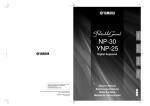

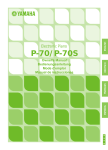
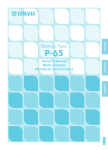
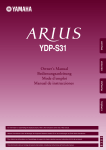
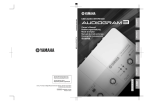
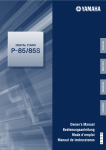
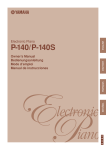
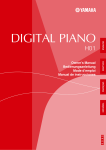

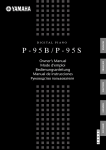
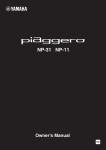
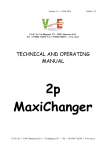
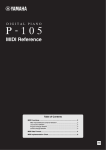
![Press the [FUNCTION] button.](http://vs1.manualzilla.com/store/data/005738170_1-cd4fded3b03c9e88548afe52897345e1-150x150.png)
